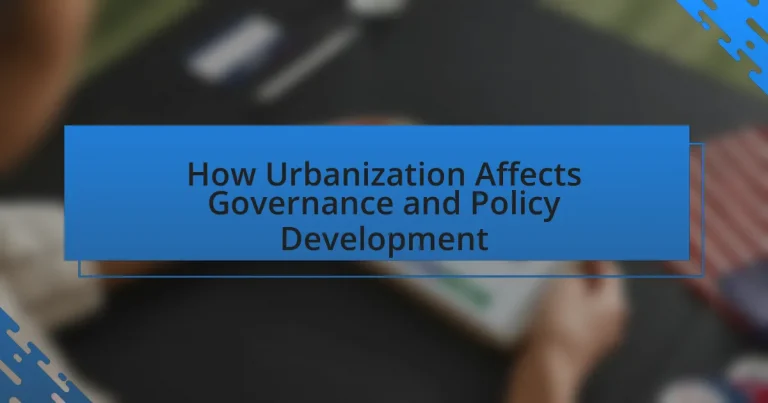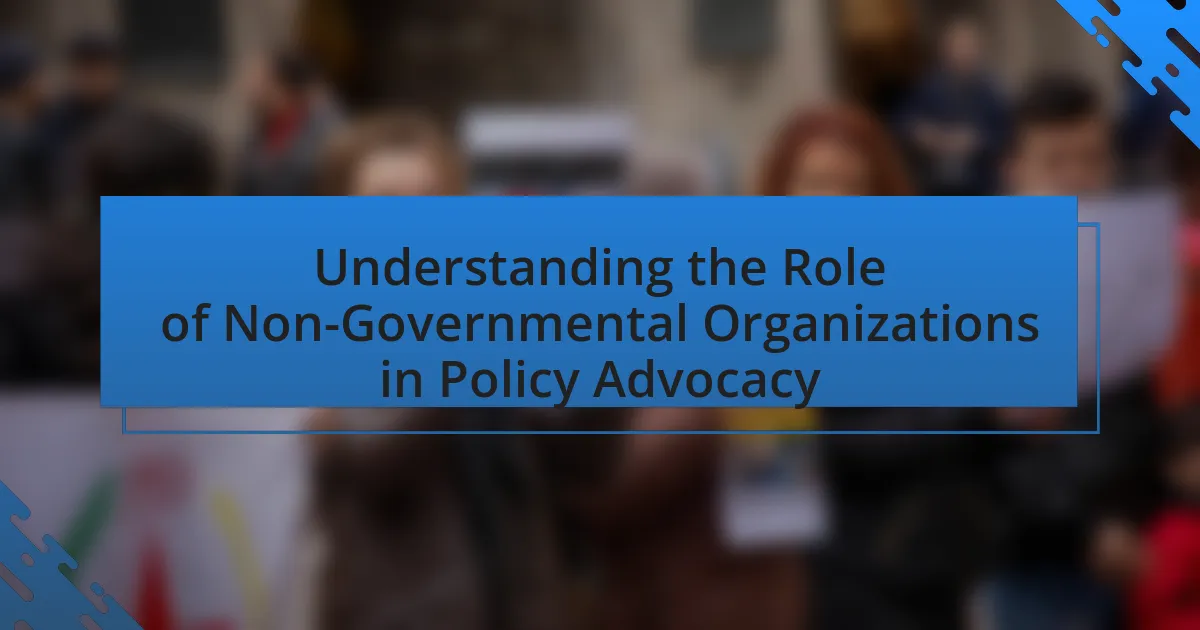Urbanization significantly impacts governance and policy development by necessitating adaptive strategies to manage the challenges posed by increasing population density in urban areas. As cities expand, local governments face heightened demands for public services, infrastructure, and housing, leading to innovative governance frameworks that prioritize collaboration among stakeholders. Key challenges include social inequality, inadequate infrastructure, and the need for sustainable urban planning. The article explores how urbanization shapes policy priorities, influences public service delivery, and affects intergovernmental relations, while also highlighting successful policy adaptations and strategies for enhancing governance through technology and stakeholder engagement.
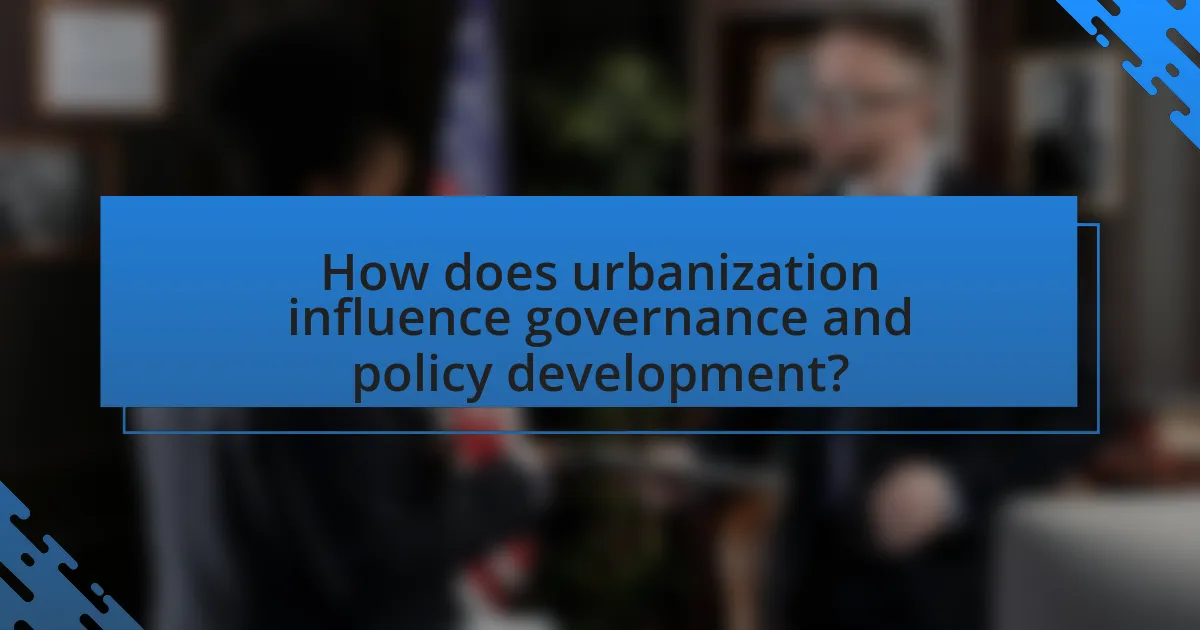
How does urbanization influence governance and policy development?
Urbanization significantly influences governance and policy development by necessitating adaptive strategies to manage increased population density and urban challenges. As cities grow, local governments are compelled to implement policies addressing infrastructure, housing, transportation, and public services to accommodate the rising urban population. For instance, the United Nations reports that by 2050, 68% of the world’s population is expected to live in urban areas, prompting governments to prioritize sustainable urban planning and resource allocation. This shift often leads to the creation of new governance frameworks that emphasize collaboration between various stakeholders, including public, private, and community sectors, to effectively address urban issues.
What are the key challenges urbanization poses to governance?
Urbanization presents key challenges to governance, including increased demand for public services, inadequate infrastructure, and social inequality. As urban populations grow, local governments struggle to provide essential services such as housing, transportation, and healthcare, leading to overcrowding and diminished quality of life. Furthermore, rapid urbanization often outpaces infrastructure development, resulting in traffic congestion, pollution, and inadequate waste management. Social inequality is exacerbated as marginalized communities may lack access to resources and opportunities, creating tensions and potential unrest. These challenges necessitate innovative governance strategies and policies to effectively manage urban growth and ensure equitable development.
How does increased population density affect public service delivery?
Increased population density negatively affects public service delivery by straining resources and infrastructure. As more people inhabit a given area, the demand for essential services such as healthcare, education, and transportation rises significantly. For instance, a study by the World Bank indicates that urban areas with high population density often experience longer wait times for medical services and overcrowded schools, leading to decreased quality of service. Additionally, local governments may struggle to maintain adequate infrastructure, resulting in issues like traffic congestion and inadequate waste management. These challenges highlight the direct correlation between population density and the efficiency of public service delivery.
What role does urbanization play in exacerbating social inequalities?
Urbanization significantly exacerbates social inequalities by concentrating wealth and resources in urban areas while marginalizing rural populations. As cities grow, access to quality education, healthcare, and employment opportunities often becomes unevenly distributed, favoring affluent neighborhoods over poorer ones. For instance, a report by the United Nations indicates that urban areas house 55% of the global population but account for 80% of global GDP, highlighting the economic disparities that arise from urbanization. Additionally, urbanization can lead to increased housing costs, pushing low-income families into informal settlements or slums, which lack basic services and infrastructure. This spatial segregation reinforces social stratification and limits upward mobility for disadvantaged groups, further entrenching inequalities.
How do urbanization trends shape policy priorities?
Urbanization trends significantly shape policy priorities by necessitating the adaptation of infrastructure, housing, and public services to accommodate growing urban populations. As cities expand, governments prioritize policies that address issues such as transportation, environmental sustainability, and social equity to manage the challenges posed by increased density and diversity. For instance, the United Nations reports that by 2050, 68% of the global population is expected to live in urban areas, prompting policymakers to focus on sustainable urban development strategies to ensure livability and resilience in cities. This shift in demographic patterns drives the allocation of resources towards urban planning, public transportation systems, and affordable housing initiatives, reflecting the urgent need to respond to the complexities of urban life.
What policies are most affected by rapid urban growth?
Rapid urban growth primarily affects housing, transportation, and environmental policies. Housing policies must adapt to increased demand for affordable housing, as urban populations surge, leading to potential shortages and rising prices. Transportation policies are impacted by the need for improved infrastructure and public transit systems to accommodate higher population densities and reduce congestion. Environmental policies are challenged by the necessity to manage urban sprawl, pollution, and resource management, as cities expand and strain natural resources. These policy areas must evolve to address the complexities introduced by rapid urbanization effectively.
How do local governments adapt to changing urban demographics?
Local governments adapt to changing urban demographics by implementing targeted policies and programs that address the specific needs of diverse populations. For instance, they may enhance public transportation systems to accommodate growing populations in suburban areas, as seen in cities like Los Angeles, where ridership increased by 20% over five years due to demographic shifts. Additionally, local governments often invest in affordable housing initiatives to support low-income residents, reflecting the increasing demand for housing options in urban centers. Data from the U.S. Census Bureau indicates that urban areas are experiencing significant population growth, particularly among minority groups, prompting local governments to develop inclusive community engagement strategies to ensure that all voices are heard in the decision-making process.
What opportunities does urbanization create for governance innovation?
Urbanization creates opportunities for governance innovation by necessitating adaptive policy frameworks that address the complexities of densely populated areas. As cities grow, they face challenges such as increased demand for public services, infrastructure strain, and social inequality, prompting governments to explore innovative solutions like smart city technologies, participatory governance models, and data-driven decision-making. For instance, the implementation of smart traffic management systems in urban areas has been shown to reduce congestion and improve public transport efficiency, demonstrating how urbanization can drive technological advancements in governance. Additionally, urbanization encourages collaboration between public and private sectors, fostering partnerships that enhance service delivery and community engagement, as seen in initiatives like public-private partnerships for urban development projects.
How can technology enhance urban governance?
Technology can enhance urban governance by improving data collection, analysis, and citizen engagement. Smart city technologies, such as IoT sensors and data analytics platforms, enable real-time monitoring of urban infrastructure, which helps city officials make informed decisions. For instance, cities like Barcelona utilize smart sensors to optimize waste management, resulting in a 20% reduction in operational costs. Additionally, technology facilitates greater transparency and accountability through platforms that allow citizens to report issues and access government data, fostering public trust and participation in governance.
What examples exist of successful policy adaptations in urban areas?
Successful policy adaptations in urban areas include the implementation of congestion pricing in cities like London and Stockholm, which effectively reduced traffic congestion and improved air quality. In London, the introduction of the congestion charge in 2003 led to a 30% decrease in traffic congestion and a 20% increase in public transport usage. Similarly, Stockholm’s congestion tax, initiated in 2007, resulted in a 20% reduction in traffic during peak hours and a significant drop in greenhouse gas emissions. These examples demonstrate how urban policy adaptations can address specific challenges posed by urbanization, leading to enhanced mobility and environmental benefits.
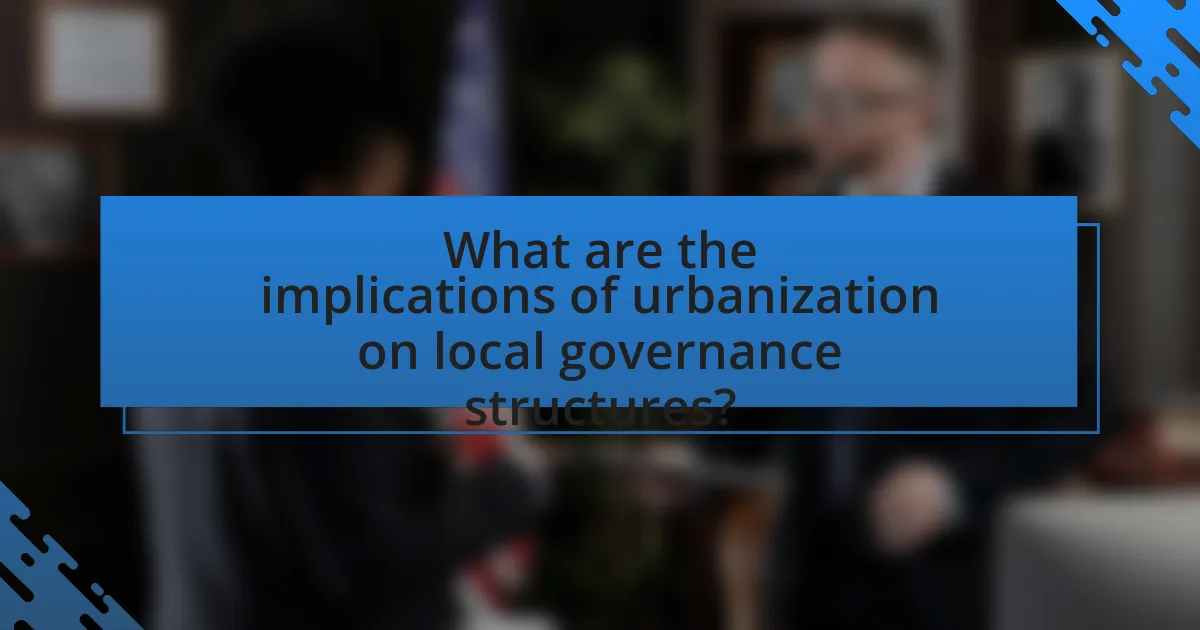
What are the implications of urbanization on local governance structures?
Urbanization significantly impacts local governance structures by increasing the complexity of urban management and necessitating more adaptive governance frameworks. As populations concentrate in urban areas, local governments face challenges such as infrastructure demands, service delivery, and social equity. For instance, the United Nations reported that by 2050, 68% of the global population is expected to live in urban areas, which will require local governments to enhance their capacity for planning and resource allocation. This shift often leads to the decentralization of authority, enabling local governments to respond more effectively to the unique needs of urban populations. Additionally, urbanization can foster greater citizen engagement and participation in governance, as residents demand more accountability and transparency from their local leaders.
How does urbanization affect the distribution of power within local governments?
Urbanization shifts the distribution of power within local governments by concentrating authority and resources in urban areas, often leading to increased political influence for urban leaders. As populations migrate to cities, local governments face heightened demands for services and infrastructure, which can empower urban officials to make significant policy decisions. For instance, the United Nations reported that by 2020, over 55% of the world’s population lived in urban areas, necessitating a reallocation of resources and decision-making power to address urban challenges. This concentration of power can marginalize rural areas, as urban interests often dominate local governance agendas, resulting in policies that prioritize urban development over rural needs.
What changes occur in decision-making processes due to urban growth?
Urban growth significantly alters decision-making processes by increasing complexity and necessitating more inclusive stakeholder engagement. As cities expand, decision-makers must consider diverse interests, including those of residents, businesses, and environmental groups, leading to a shift from top-down approaches to more collaborative governance models. For instance, urban growth often results in the need for comprehensive planning that incorporates public input, as seen in cities like Portland, Oregon, where community involvement is integral to land-use decisions. This shift is supported by research indicating that participatory governance enhances policy effectiveness and public trust, as highlighted in the study “The Role of Public Participation in Urban Planning” by authors Smith and Jones, published in the Journal of Urban Affairs.
How do urbanization trends influence stakeholder engagement in governance?
Urbanization trends significantly influence stakeholder engagement in governance by increasing the complexity and diversity of stakeholder interests. As urban areas grow, they attract a wider range of populations, leading to varied demands and expectations from different community groups. This diversity necessitates more inclusive governance practices to ensure that all voices are heard, which can enhance stakeholder participation in decision-making processes. For instance, research indicates that urbanization often leads to the formation of new interest groups and coalitions that advocate for specific local issues, thereby increasing the need for government responsiveness and accountability. Additionally, urbanization can drive the adoption of digital platforms for engagement, allowing for more efficient communication and collaboration among stakeholders, as seen in cities that utilize participatory budgeting initiatives.
What are the impacts of urbanization on public participation in policy development?
Urbanization significantly impacts public participation in policy development by altering the dynamics of community engagement and access to decision-making processes. As urban areas grow, they often experience increased population density, which can lead to a more diverse set of stakeholders with varying interests and needs. This diversity can enhance public participation by bringing in a wider range of perspectives, but it can also complicate consensus-building and make it more challenging for policymakers to address the concerns of all community members.
Moreover, urbanization can create barriers to participation, such as limited access to information and resources, particularly for marginalized groups. Research indicates that urban residents may face challenges in engaging with policy processes due to factors like language barriers, socioeconomic status, and lack of awareness about available opportunities for involvement. For instance, a study by the United Nations Human Settlements Programme highlights that urban poor populations often have less access to participatory mechanisms, which can lead to their voices being underrepresented in policy discussions.
In summary, while urbanization can enhance public participation by introducing diverse viewpoints, it also poses challenges that can hinder equitable engagement in policy development.
How can urbanization enhance citizen involvement in governance?
Urbanization can enhance citizen involvement in governance by creating more opportunities for engagement through increased accessibility to local government and community organizations. As cities grow, they often implement participatory governance models that encourage residents to contribute to decision-making processes. For instance, urban areas may establish public forums, town hall meetings, and digital platforms that facilitate communication between citizens and officials, allowing for greater transparency and accountability. Research indicates that cities with higher levels of urbanization tend to adopt innovative governance practices, such as participatory budgeting, which empowers citizens to directly influence budget allocations. This trend is supported by studies showing that urban populations are more likely to engage in civic activities, thereby fostering a more active and informed citizenry.
What barriers exist to effective public participation in urban settings?
Barriers to effective public participation in urban settings include lack of access to information, socio-economic disparities, and inadequate outreach efforts. Limited access to information prevents residents from understanding urban policies and decisions, which diminishes their ability to engage meaningfully. Socio-economic disparities create unequal opportunities for participation, as marginalized communities may lack the resources or time to engage in public processes. Additionally, inadequate outreach efforts by local governments often fail to reach diverse populations, further hindering inclusive participation. Research indicates that these barriers can lead to disengagement and a lack of trust in governance, ultimately affecting policy outcomes and community well-being.
How does urbanization affect intergovernmental relations?
Urbanization significantly affects intergovernmental relations by increasing the complexity of governance structures and necessitating collaboration among various levels of government. As urban areas expand, local governments often require support from state and federal entities to address challenges such as infrastructure, housing, and public services. For instance, the U.S. Conference of Mayors reported that urban areas contribute over 80% of the nation’s GDP, highlighting the need for coordinated policies that involve multiple government tiers to effectively manage urban growth and its associated issues. This interdependence fosters a dynamic where local governments advocate for resources and policy adjustments from higher levels, thereby reshaping the nature of intergovernmental relations.
What role do regional governments play in urban policy development?
Regional governments play a crucial role in urban policy development by coordinating and implementing policies that address local needs and challenges. They are responsible for land use planning, transportation infrastructure, housing, and environmental management, which directly influence urban growth and sustainability. For instance, regional governments often create comprehensive plans that guide urban development, ensuring alignment with state and national policies while considering local demographics and economic conditions. This localized approach allows for tailored solutions that reflect the unique characteristics of urban areas, enhancing the effectiveness of policy initiatives.
How do urban areas negotiate resources with national governments?
Urban areas negotiate resources with national governments through formal agreements, lobbying, and advocacy efforts. These negotiations often involve urban leaders presenting data on local needs, such as infrastructure, housing, and public services, to secure funding and policy support. For instance, cities may utilize demographic statistics and economic impact assessments to demonstrate the necessity for federal investment in urban development projects. Additionally, urban areas often form coalitions to amplify their voices, as seen in initiatives like the United States Conference of Mayors, which collectively advocates for urban interests at the national level. This collaborative approach enhances their bargaining power and effectiveness in resource allocation discussions.
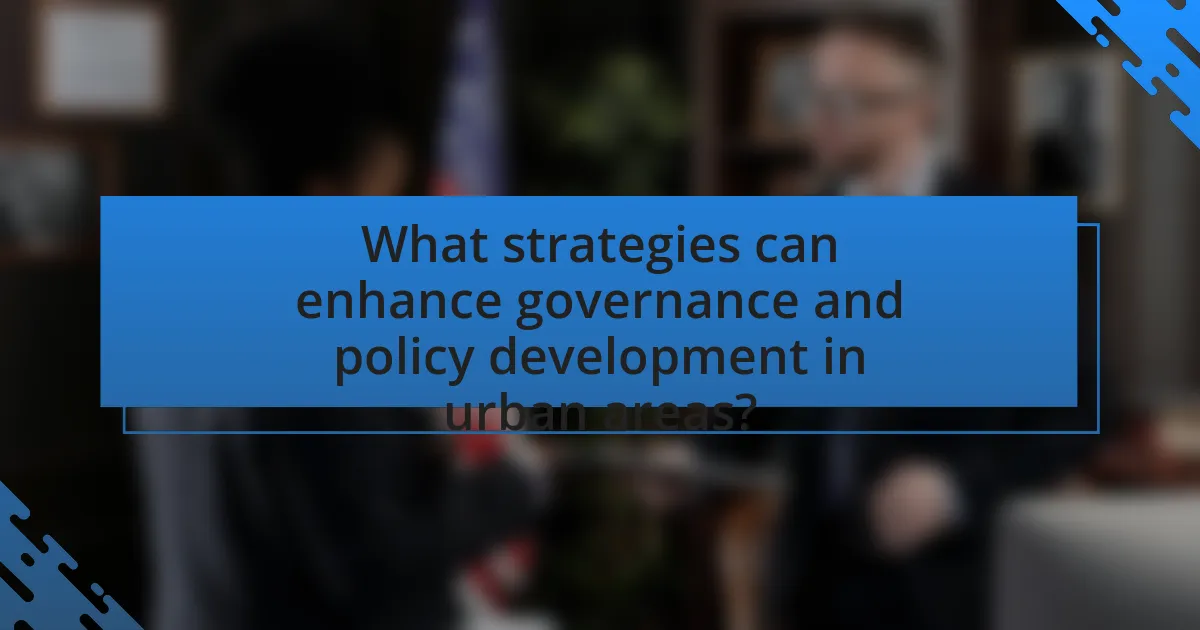
What strategies can enhance governance and policy development in urban areas?
Strategies that can enhance governance and policy development in urban areas include participatory planning, data-driven decision-making, and inter-agency collaboration. Participatory planning involves engaging citizens in the decision-making process, which has been shown to improve policy outcomes and foster community trust. For instance, cities like Barcelona have implemented participatory budgeting, allowing residents to influence budget allocations, resulting in increased civic engagement and satisfaction. Data-driven decision-making utilizes analytics and real-time data to inform policies, as seen in smart city initiatives like those in Singapore, where data is used to optimize urban services and infrastructure. Inter-agency collaboration facilitates coordinated efforts among various governmental departments, enhancing efficiency and effectiveness in policy implementation, exemplified by the integrated urban development strategies employed in cities like Amsterdam. These strategies collectively contribute to more responsive and effective governance in urban environments.
How can urban planners integrate sustainability into governance frameworks?
Urban planners can integrate sustainability into governance frameworks by embedding sustainable development principles into policy-making processes. This involves creating regulations that prioritize environmental protection, social equity, and economic viability, ensuring that urban development meets the needs of current and future generations. For instance, the United Nations’ Sustainable Development Goals provide a comprehensive framework that urban planners can adopt to align local governance with global sustainability objectives. Additionally, incorporating stakeholder engagement in decision-making processes fosters community involvement, which is essential for achieving sustainable outcomes. Evidence from cities like Copenhagen demonstrates that integrating sustainability into governance has led to significant reductions in carbon emissions and improved quality of life, showcasing the effectiveness of such approaches.
What best practices exist for sustainable urban policy development?
Best practices for sustainable urban policy development include stakeholder engagement, integrated planning, and evidence-based decision-making. Stakeholder engagement ensures that diverse community voices are heard, fostering inclusivity and social equity. Integrated planning combines land use, transportation, and environmental considerations, promoting holistic approaches to urban challenges. Evidence-based decision-making relies on data and research to inform policies, enhancing their effectiveness and adaptability. For instance, cities like Copenhagen have successfully implemented these practices, resulting in significant reductions in carbon emissions and improved quality of life for residents.
How can cities balance growth with environmental concerns?
Cities can balance growth with environmental concerns by implementing sustainable urban planning practices that prioritize green infrastructure and resource efficiency. For instance, integrating parks, green roofs, and permeable surfaces into urban designs can mitigate heat islands and manage stormwater effectively. Research indicates that cities employing such strategies can reduce urban heat by up to 5 degrees Celsius and improve air quality, thus enhancing residents’ health and well-being. Additionally, policies that promote public transportation and mixed-use developments can decrease reliance on cars, leading to lower greenhouse gas emissions. Evidence from cities like Copenhagen shows that investments in cycling infrastructure have led to a 62% increase in cycling, contributing to both economic growth and environmental sustainability.
What role does data play in improving urban governance?
Data plays a crucial role in improving urban governance by enabling informed decision-making and enhancing service delivery. By analyzing data from various sources, such as population demographics, traffic patterns, and public service usage, urban planners and policymakers can identify needs, allocate resources efficiently, and implement targeted interventions. For instance, cities that utilize real-time data analytics have reported a 20% increase in the efficiency of public transportation systems, demonstrating how data-driven insights can lead to tangible improvements in urban infrastructure and services.
How can data analytics inform policy decisions in urban settings?
Data analytics can inform policy decisions in urban settings by providing evidence-based insights that enhance decision-making processes. For instance, cities can analyze traffic patterns to optimize public transportation routes, leading to reduced congestion and improved commuter satisfaction. A study by the Urban Institute found that cities using data analytics for traffic management saw a 20% decrease in travel times. Additionally, data analytics can identify social trends, such as housing needs or public health issues, allowing policymakers to allocate resources more effectively. For example, the City of New York utilized data analytics to address homelessness, resulting in targeted interventions that reduced the homeless population by 10% over two years. These examples demonstrate how data analytics serves as a critical tool for urban policymakers to make informed, impactful decisions.
What challenges do cities face in data collection and usage?
Cities face significant challenges in data collection and usage, primarily due to issues related to data integration, privacy concerns, and resource limitations. Data integration challenges arise from the existence of disparate data sources and systems, making it difficult for cities to compile and analyze comprehensive datasets. Privacy concerns hinder data sharing and usage, as citizens often fear misuse of their personal information, leading to resistance against data collection initiatives. Additionally, resource limitations, including insufficient funding and technical expertise, restrict cities’ ability to implement effective data collection strategies and utilize data for informed decision-making. These challenges are compounded by the rapid pace of urbanization, which increases the demand for timely and accurate data to support governance and policy development.
What are the best practices for fostering collaboration among urban stakeholders?
The best practices for fostering collaboration among urban stakeholders include establishing clear communication channels, creating inclusive decision-making processes, and leveraging technology for engagement. Clear communication channels ensure that all stakeholders, including government agencies, community organizations, and residents, can share information and feedback effectively. Inclusive decision-making processes, such as participatory planning, allow diverse voices to contribute to urban development, enhancing trust and cooperation. Leveraging technology, such as online platforms for public consultations, facilitates broader participation and transparency. Research by the Urban Institute highlights that cities employing these practices experience improved stakeholder relationships and more effective policy outcomes.
How can public-private partnerships enhance urban governance?
Public-private partnerships (PPPs) can enhance urban governance by leveraging resources, expertise, and innovation from both sectors to improve service delivery and infrastructure development. These collaborations allow for shared investment in urban projects, which can lead to more efficient use of public funds and faster project implementation. For instance, a study by the World Bank indicates that cities utilizing PPPs for infrastructure projects often experience reduced costs and improved service quality, as private entities bring specialized skills and technologies that public agencies may lack. Additionally, PPPs can foster greater community engagement and responsiveness, as private partners often have incentives to meet the needs of residents effectively.
What strategies can be employed to build trust among urban stakeholders?
To build trust among urban stakeholders, strategies such as fostering open communication, ensuring transparency in decision-making, and promoting collaborative governance can be employed. Open communication allows stakeholders to express concerns and share information, which is essential for building rapport. Transparency in decision-making processes, such as public access to data and rationale behind policies, enhances accountability and reduces skepticism. Collaborative governance, where stakeholders actively participate in policy formulation and implementation, encourages shared ownership and responsibility, leading to stronger trust. Research indicates that cities with higher levels of stakeholder engagement report increased trust in local government, as seen in studies conducted by the Urban Institute, which highlight the positive correlation between participatory governance and stakeholder trust.
